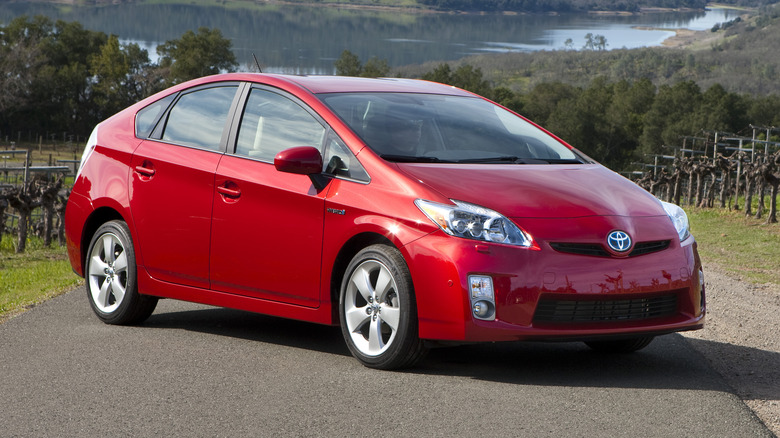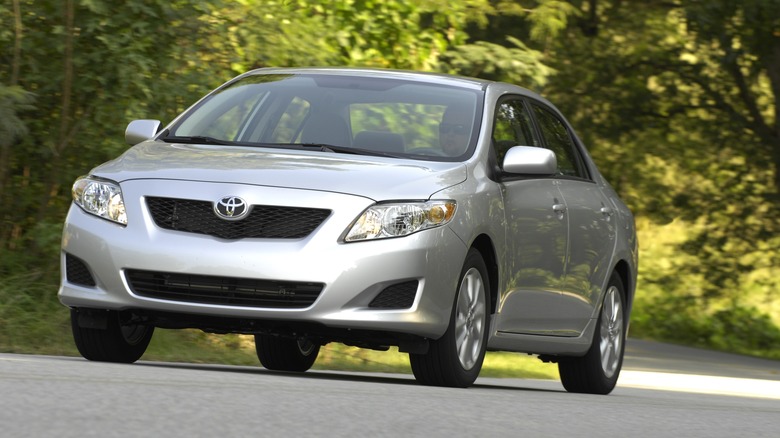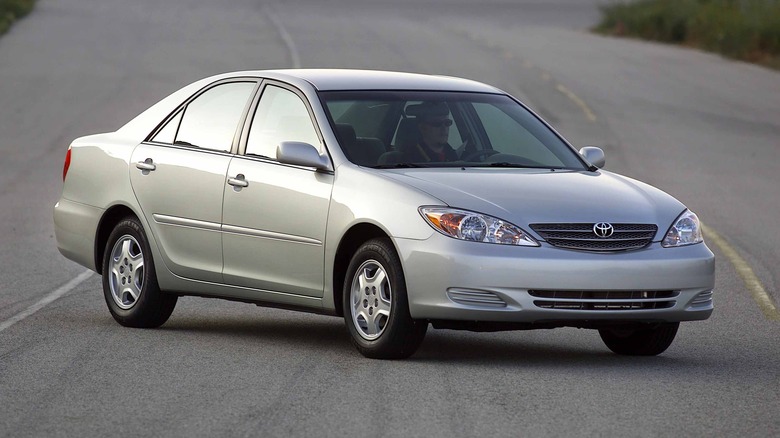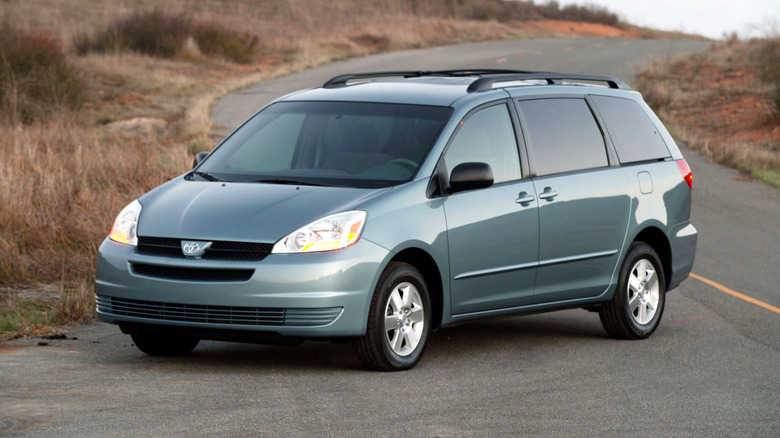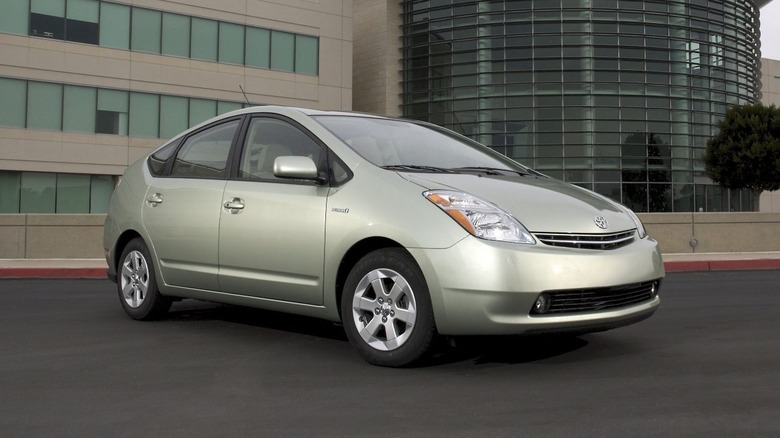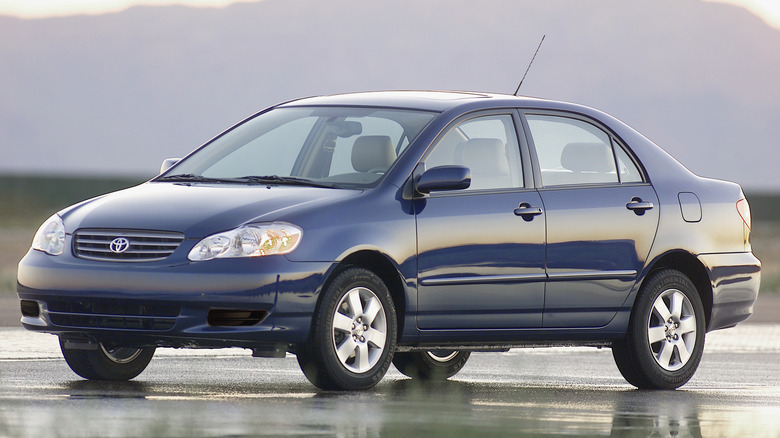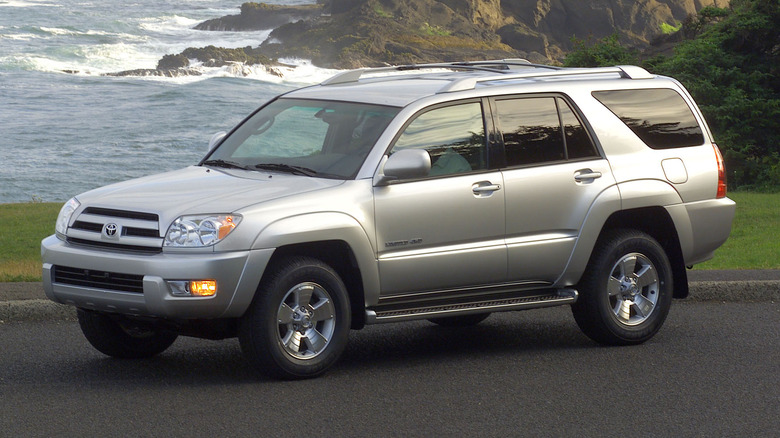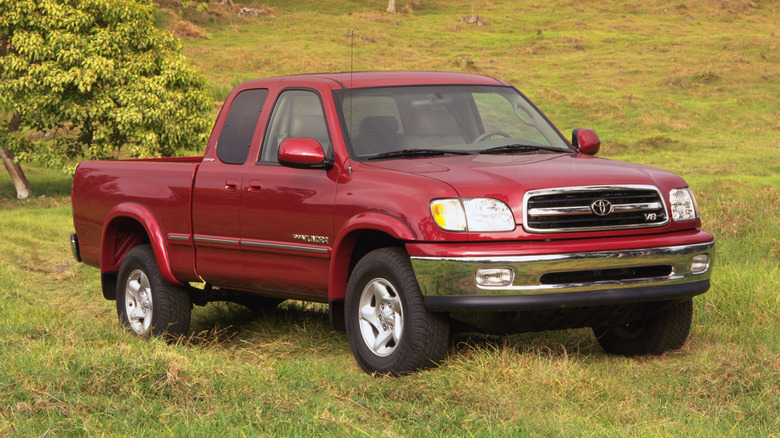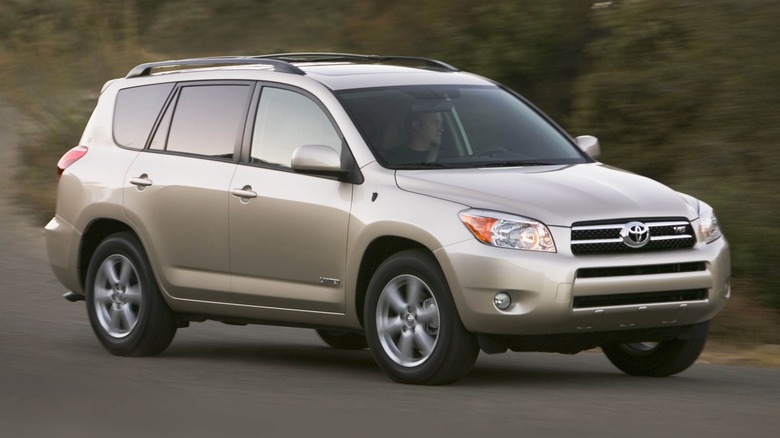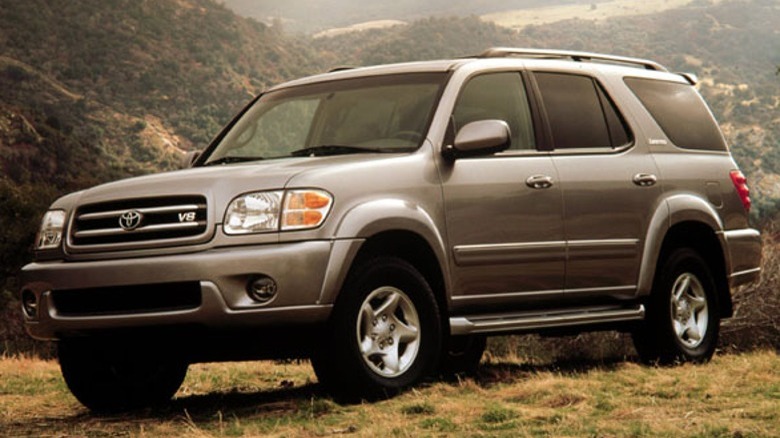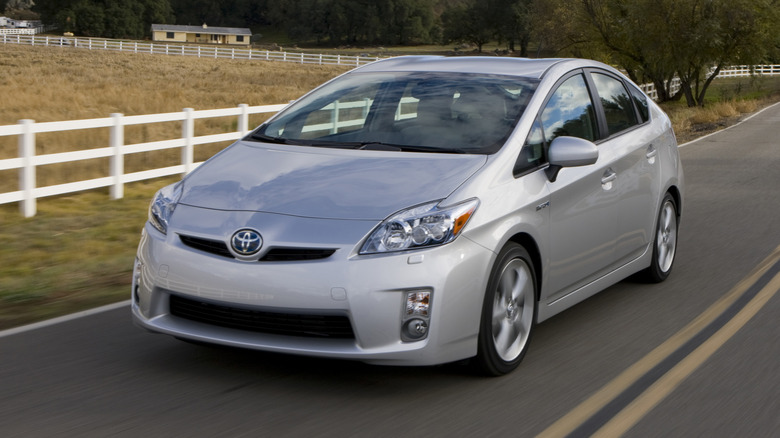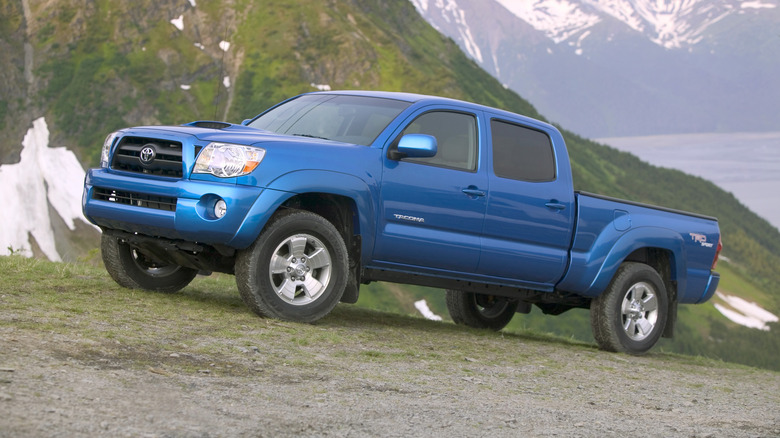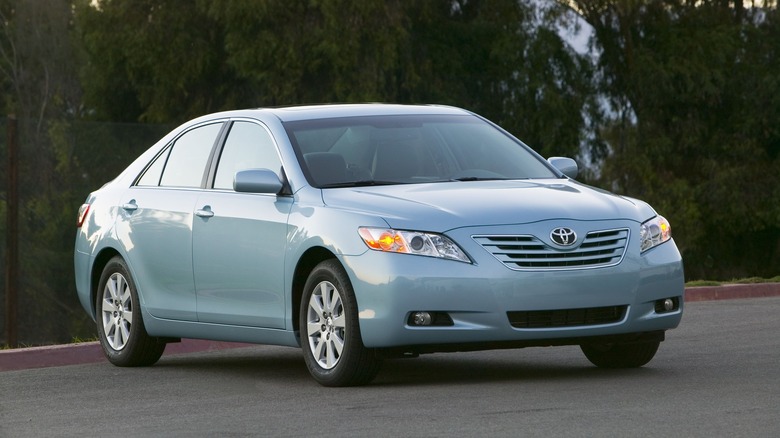12 Used Toyota Models You Should Steer Clear Of At All Costs
Toyota consistently ranks among the most reliable automakers on the market and boasts a hard-earned reputation for its build quality. Buyers can count on Toyota's cars to deliver a lifetime of trouble-free driving, with minimal need for costly repairs. However, not all of Toyota's models have managed to live up to the high bar the Japanese brand has set for itself over the years.
Owners of certain older Toyota cars have complained of a wide variety of issues, from excessive rust to unexpected brake failure. These issues affect many of the brand's bestselling vehicles, sometimes with multiple model years affected. SlashGear has rounded up a selection of the most problematic Toyotas using data sourced from the NHTSA, each with a significantly higher rate of owner complaints than average. This isn't an exhaustive guide to every model year with known flaws, but rather intended as a general guide to give used car buyers an idea of which cars are most worth avoiding.
2009 Toyota Corolla
The 10th generation of the bestselling Toyota Corolla was launched for the 2009 model year, with iterative improvements made over the outgoing model. While it might have benefitted from revised styling and an improved power output, the 2009 model also suffered higher instances of reliability issues. It has recorded nearly five times more complaints to the NHTSA than the previous model year, with over 1,500 complaints as of this writing. It's also been subject to 13 recalls. Five of those recalls concern the car's Takata airbags, with the most recent being issued in 2019.
Concerning used buyers, reports of faulty airbags have continued to be filed in the years since those recalls, suggesting there is still a minority of 2009 Corollas that have not had the required recall work carried out. Likewise, two recalls were issued in 2010 to address the possibility that the car's accelerator pedal could become stuck on, but NHTSA complaints have continued to appear regarding 2009 Corollas with the stuck throttle fault as recently as January 2024.
The sticking accelerator pedal recall affected 2.2 million Toyota vehicles, although it's unknown how many were never taken in for remedial work. With its high instances of recalls and owner complaints, used buyers should take extra care to ensure any 2009 Corolla they consider comes with evidence showing the necessary repair work has been completed. Better yet, give the model year a miss altogether.
2002 Toyota Camry
Another Toyota bestseller, the Camry was given an overhaul for the 2002 model year. While the vast majority of owners have never reported issues with their cars, the 2002 Camry does suffer a higher rate of owner complaints to the NHTSA than other model years. To date, more than 1,000 complaints have been lodged with the agency, and the car has been subject to four recalls. Only one recall, however, affected a significant proportion of cars sold that year, with two recalls affecting less than twenty examples of the 2002 Camry.
What earns it a spot on the list of Toyota models to avoid is not the issues the car did see recalls for, but rather what it didn't. Hundreds of owners have reported issues with surging acceleration, where the car uncontrollably accelerates with no prior warning. In addition, over a hundred reports to the NHTSA allege that the Camry's brakes suffered partial or total failure while driving.
Three separate investigations were opened by the NHTSA into the surging acceleration issue, but none of those investigations could find evidence to pin the problem down to a specific defect. All three were closed without further action being taken. While the 2002 Camry is the most complained about model year of its generation, every other model year between 2002 and 2006 is also subject to higher levels of complaints than average, with hundreds of those alleging the same unintended acceleration issue.
2004 Toyota Sienna
Only a handful of Toyota models hold the unfortunate distinction of having over 2,000 owner complaints filed with the NHTSA, and the 2004 Sienna minivan is one of them. It has also been subject to 10 recalls. Owner complaints are mostly centered around a few key issues, with defective sliding rear doors being one of the most common. Others center around an allegedly weak door weld, which has been reported to create a loud popping sound when it fails.
Some drivers also report that the rear hatch fails to open as intended thanks to a defect involving the liftgate support struts. A recall was issued in 2008 for the 2004-2006 Sienna to correct the potentially faulty struts, but owners continued to report issues with them over 10 years after the initial recall. As is often the case with such reports, it's not clear whether the affected cars didn't get the original recall work completed or whether the replacement parts were also faulty. While the 2004 Sienna is the most frequently complained about, the 2005 and 2006 Siennas don't fare much better. Both have over 1,000 owner complaints filed with the NTSA to date.
2007 Toyota Prius
The second-generation Prius launched the hybrid car into the mainstream, offering market-leading efficiency and unique, if polarizing, styling. However, second-generation Priuses have more complaints on average than other generations of the car, with the 2007 model year being the worst offender. Nearly 2,000 complaints have been registered with the NHTSA as of this writing, with the car being subject to four recalls.
Over half of those complaints involve issues with the car's headlights. Owners report that one headlight would flicker repeatedly or fail, although in many cases, they could be restored by toggling the headlight switch off and on again. The NHTSA launched an investigation into the issue in 2009, ultimately concluding that "a safety defect trend [had] not been identified."
The 2007 Prius is also one of the millions of Toyota cars that were subject to a recall for accelerator pedal entrapment, and was also subject to two notable model-specific recalls. One involved a potentially defective water pump, while the other was issued due to a risk of a shaft in the steering system breaking. Owner complaints only document a very small number of issues with these two failure points in the years since their respective recalls.
2005 Toyota Corolla
The 2005 Toyota Corolla did exactly what buyers of every Corolla generation expected it to do: deliver affordable, practical motoring with a choice of trims ranging from slightly sluggish to pleasingly brisk. However, it wasn't quite as stereotypical of Toyota's famed reliability, with over 900 complaints and 11 recalls logged with the NHTSA to date. Six of those recalls concerned faulty Takata-supplied airbags — an extremely common issue for cars of its age, and not limited to the Corolla nor Toyota itself. However, it appears there are still plenty of 2005 Corollas on the road with defective airbags even after the recalls, with over 500 complaints recorded, many stating an airbag warning light was present even after recall work was carried out.
Four further recalls affected only a small number of cars and concerned incorrect lighting reflectors. That was a relatively minor issue compared to the most significant recall, issued in 2010. Over 1.1 million Corollas manufactured between 2005 and 2008 were recalled due to a faulty engine control module which increased the chance of the engine stalling. A small number of owners reported persistent issues with stalling even after the recall. Another alleged weakness of the 2005 Corolla is the AC compressor, which a minority of owners have reported to be prone to premature failure.
2003 Toyota 4Runner
The fourth-generation Toyota 4Runner is an outlier in the nameplate's history, as it's the only generation to be worth less on the used market than the generation that directly precedes it. Perhaps the lower value of the fourth-generation SUV, which was introduced for the 2003 model year, is down to its higher rate of owner complaints: the NHTSA has so far recorded over 700 of them, as well as registering three recalls. Only two of those recalls affect any notable number of cars: one concerns the risk of a leak in the fuel system, while the other, broader recall is due to a risk of unintended acceleration due to pedal entrapment.
Owner complaints highlight several other alleged areas of concern, including excessive corrosion of the vehicle's frame affecting its structural integrity. Rust is also reported to be an issue for areas of the suspension, with some owners reporting partial suspension failure while driving. While there are ways to prevent a car from rusting, once it's established, it's almost always very costly to fix. In most cases, it's financially unviable for most owners, which leaves scrapping the car the only option once the rust becomes terminal.
2000 Toyota Tundra
The 2003 4Runner isn't the only Toyota of its age to have well-documented structural issues. The 2000 Toyota Tundra also reportedly suffers from excessive structural corrosion, just one of the reasons that earned it a spot on the worst performers list. The truck has drawn over 1,000 complaints to the NHTSA to date, alongside nine recalls. More than half of those complaints specifically cite corrosion as a reason for contacting the agency, with many mentioning frame rust. The Tundra's ball joints are also a reported area of concern, with some drivers reporting a loss of control after a ball joint failed while on the road.
An investigation was conducted by the NHTSA in 2009 which resulted in a recall being issued for the excessive frame corrosion, with many surviving Tundras now benefitting from a replacement frame. However, some reports allege owners were told they would have to pay for other corroded parts linked to the corroded frame, but not covered by the recall. To avoid potentially costly repair work regarding rust altogether, it's arguably best for used buyers to steer clear of the 2000 Tundra.
2007 Toyota RAV4
According to owner complaints filed with the NHTSA, the 2007 Toyota RAV4 suffers from a variety of issues ranging from excessive oil consumption to visibility issues caused by a drooping sun visor. Close to 1,000 complaints have been made to date, with 14 recalls issued for the car. Several recalls concern the corrosion of rear suspension components, while two further recalls concern a melting power window master switch.
The 2007 RAV4 is also one of several top-selling Toyota models affected by the expansive pedal entrapment recall that could result in unintended acceleration if not fixed. Over 100 drivers have reported vehicle speed control issues potentially related to this recall, although no further instances have been reported within the last five years. Another common complaint is the steering system, which hundreds of owners report makes a noise when the car is turned. As of this writing, no formal investigation has been opened into the alleged problem.
2002 Toyota Sequoia
The 2002 Toyota Sequoia has been subject to one more recall than the 2003 model year, yet it still allegedly has more problems than its successor. The 2003 Sequoia has drawm to seven recalls to date, with one of those regarding an issue with the stability control system. A fault with ECU programming can cause the vehicle stability control system to temporarily activate at low speed, according to the recall documentation. The 2002 Sequoia has not been subject to the same recall, despite hundreds of owners reporting the same issue to the NHTSA. That alleged oversight saw the 2002 Sequoia top the charts for complaints, receiving nearly 700 as of this writing, as well as the eight recalls above.
Four concern the Takata airbags fitted to the SUV, while another addresses the potential for a brake master cylinder leak. The Sequoia is also one of several Toyota models of its age to be recalled for ball joint failure. Owner complaints include a small number of allegations related to each of these recalls, but all of them are in far smaller numbers than the issues with the vehicle stability control system. It seems that, despite Toyota deciding to recall the following model year, the brand's refusal to issue a VSC recall for the 2002 Sequoia makes it well worth avoiding on the used market.
2010 Toyota Prius
There have been 10 recalls for the 2010 Toyota Prius as of this writing, but none have addressed what many owners allege is the car's biggest issue: sudden and unexpected failure of its brakes. The 2010 model year is the most complained about Prius according to NHTSA data, with over 2,700 owner complaints. Over 1,800 of those allege a problem with the car's brakes, with many reporting a burst of warning lights on their car's dash had appeared while driving, followed by the partial or total failure of its braking system.
An investigation into the problem was first launched by the NHTSA in 2019 but was later scrapped after the original complainant withdrew their allegation. As of November 2023, the investigation has been reopened at the request of a new petitioner and is ongoing as of this writing. Until a decision is made by the agency over whether a significant safety defect does exist, as has been reported by so many owners, used buyers should steer clear of the car.
2006 Toyota Tacoma
Even when a manufacturer identifies and attempts to address a concern found with one of its vehicles, there's no guarantee that the remedy will be effective for all owners. The 2006 Toyota Tacoma is a good example. After an issue was found with excessive frame corrosion, the automaker issued a time-limited recall period where owners could get their truck's frame replaced. However, a concerning number of reports filed with the NHTSA allege that the offer didn't solve the problem it claimed to. To date, more than 700 complaints have been filed, with 11 other recalls also currently active for the truck.
Owner complaints allege a variety of issues with severe corrosion, with some claiming they took the truck to a dealer when the offer was first launched and were told that their truck's frame wasn't corroded enough to need the free replacement. Years later, these trucks began to suffer from frame corrosion, but owners were then told that the time period for free replacement had expired and they'd have to pay for the work to be carried out. Others claim not to have been made aware of the frame replacement offer until after the claim period expired.
2007 Toyota Camry
The Toyota car with the highest number of owner complaints recorded by the NHTSA is the 2007 Camry, with over 3,500 filed as of this writing. A total of 11 recalls are also open for the car. Owner reports allege several issues with the car, many of which are shared with other problematic Toyota models included in this list.
The vehicle speed control system and brakes are common areas of concern, with drivers reporting various dashboard warning lights unexpectedly appearing followed by partial loss of the braking system. Some report that dashboard lights indicated an issue with the vehicle stability control system, while others report issues after an ABS warning light appeared. After an NHTSA investigation, an extended warranty period for the brake actuator was granted in 2014 but has now expired.
Other owners allege that their dashboard has melted and causes dangerous amounts of glare, and there are also dozens of reports involving a defective sun visor that can fall down and obstruct the driver's view while on the road. With multiple potentially dangerous issues identified by owners, the 2007 Camry is well worth avoiding for anyone looking for a safe and hassle-free used car ownership experience.
Our selection methodology
Toyota is known for building safe, reliable cars, which is why used car buyers will want to stay well away from the small number of model years that don't meet the brand's usual levels of build quality. To establish which cars in Toyota's back catalog were most troublesome, SlashGear examined data from the NHTSA concerning owner complaints, past and present investigations, and recalls. This data covered every Toyota model officially sold in the United States since 1990 and provided an overview of the safety issues that had been documented for each model.
Owner complaints were considered as the primary criteria for deeming a car worth steering clear of, with recall data also considered as secondary criteria. High numbers of recalls do not inherently make a car less safe assuming the recall work has been carried out as required — however, it can be very difficult for used buyers to accurately verify that all of the required recalls have been completed. Therefore, a higher number of recalls increases the chance that any given used car has not had one or more of those recalls remedied.
